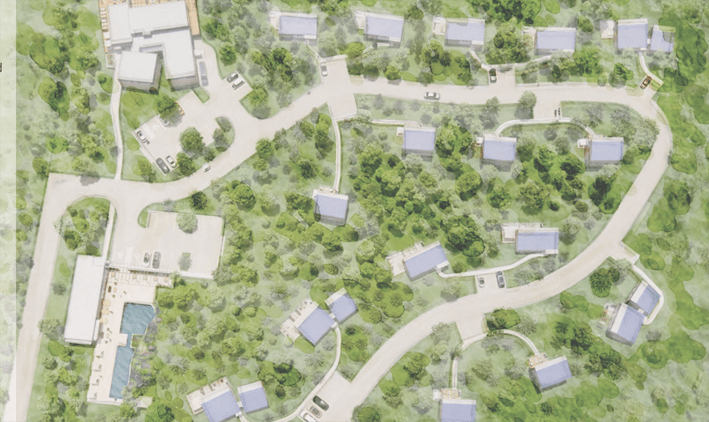 TRAE Planning graphic)
TRAE Planning graphic)
The viability of a sustainable eco-tourism model was debated at a public meeting for the TRAE Resort proposed for County Road 7 at Rock Crossroad in Cressy.
The early-stage meeting was held virtually on June 28. The 24 participants represented the project’s planners, County staff, and near neighbours of the proposed resort.
The three-season resort would feature of mix of 33 freestanding cabins, a club house, outdoor heated pool, spa, and an event space for 50 people.
One of the owners is Alan Hirschfield, well known in the County already for his prominent role in four years of public consultations and plans for the Fields of Wellington project.
The land for that project was purchased by the Kaitlin group in 2022, which promised to honour plans created in close consultation with the community and featuring dense designs, high walkability, laneway houses, and rental units.
“That was a business decision, there is nothing more I can say about it, but we felt really badly about it,” said Mr. Hirschfield.

The site of the proposed TRAE resort is outside of a core area of protection. (TRAE planning graphic)
He has since become actively involved in other projects in the County. He insists the proposed TRAE resort is “an eco-resort that is really an eco-resort.”
“We are aiming at people interested in the rural remove, in the natural aspects of the County, in the wildlife. We won’t have any landscape lighting, we will use only red lighting at night, because bats are negatively affected by irregular outdoor lighting. Special care is being taken of turtle pathways moving from water to land. Just 1.84 per cent of the land area will be built, in fact – pretty minimal, as small as possible while still creating a viable resort,” he explained.
“We were told we must use a light touch to develop a property like this, and that is what we are using.”
The lot is part of the Cressy natural core area, though through a chance swerve in the map line, it falls just outside the designated protected zone. “It really is continuous with that core, though,” noted project planner Kelly Graham. “It’s ecologically sensitive, there are wetlands and coniferous forest woodlands and a 30-metre escarpment. We are not proposing development in or even close to any of those areas. It is all set well back from the Environmental Protection zone along the escarpment and appropriate boundaries are maintained.”
Councillor John Hirsch noted that natural core areas of protection now cover a full third of the county. “It was a major victory in the Official Plan to have those natural core areas. We have protected environmentally sensitive areas across the county. And the PPS (Provincial Policy Statement) has not touched this concept of natural core areas. So we can keep them in our Official Plan. We are protecting a lot with that mapping.”
An application for another eco-resort in a similar location, called IRTH, fell through because the site for the proposed development fell within the Cressy natural core area.
TRAE’s 30-acre parcel is designated shore land, which permits tourism related development, but, as Ms. Graham explained, “that comes with a stewardship ethic. We want to be a leader in showing what is possible in sustainable, even regenerative, tourism.
“We wanted to use the opportunity to showcase site strategies, such as pedestrian-only access, and using plants for water filtration in the pool. This is a future-facing, low-carbon tourism destination.”
The resort will use a shore well rather than land well, to draw water from the Bay of Quinte than drill into the sensitive aquifer of the county. Soil will be imported to create a shallow septic bed, avoiding intense construction. A proposed pre-treatment pool minimizes the actual septic bed. The septic system alone will limit the number of people that can be onsite at any given time, noted Mr. Hirschfield.
A neighbour of the proposed project, Daniel Wigdor, noted that the “noise study had significant flaws and was dismissive of language of the noise bylaw.” Another near neighbour, David Fast, asked that the team do more to address the impacts of sound, such as music playing from boats in a possible marina.
Mr. Hirschfield dismissed any idea of a marina, “Our intent is to make the waterfront a passive area, with floating docks and decks with booms to protect swimmers from boats. We are not intending to bring motor boats into an area set aside for swimming and picknicking. This is not intended to be party central. We don’t have docking facilities for power boats.”
A number of participants worried about preserving the calm quiet of Cressy and Waupoos. Debra Marshall worried the existing east-west wildlife corridor would be fractured. “No development along an ecologically sensitive wildlife corridor is really going to be welcome, or ‘eco’,” she said. “No resort with hundreds of people walking or taking golf carts down trails could properly respect a wildlife corridor,” she said.
Liz Howes from Waupoos asked, “why not develop closer to the towns? I’m concerned about people leaving the resort for the day, and driving to wineries and cideries. I’m in favour of development in places marked for development.”
The next statutory public meeting comes in late summer.
See it in the newspaper